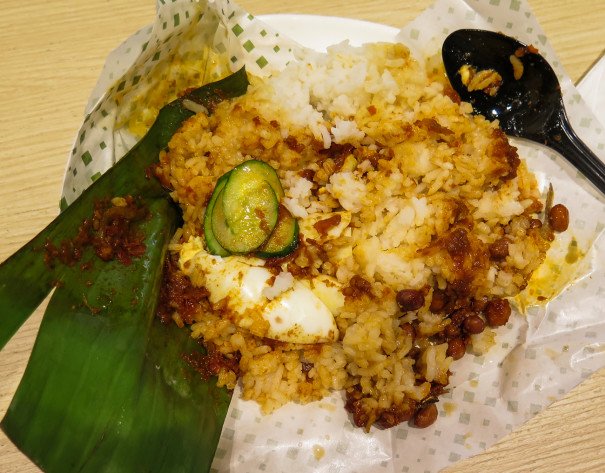
Fat Rice That’s Out of This World

Fat Rice That’s Out of This World
Nasi Lemak in Malaysia
There are conspiracy theories speculating that Egypt’s pyramids are the works of tech-savvy aliens who visited Africa thousands of years ago. In Malaysia, on the other hand, pyramids are constructed in miniature, people eat them, and they are made to be comfortably consumed from the street corner to outer space.
It was in 2007 that Malaysia’s iconic, pyramid-shaped breakfast package, nasi lemak—essentially coconut milk-soaked rice with spicy sauce—was selected as one of the nation’s quintessential icons. It was judged worthy to be carried to and eaten in the stratosphere by the first Malaysian astronaut, Dr. Sheikh Muszaphar (a man who, besides having the pleasure of eating nasi lemak in outer space, also had to figure out the most effective way to pray towards Mecca while floating in microgravity).
But let’s return to planet Earth, and to every Malaysian roadside stall, hole-in-the-wall store, and even fancy restaurant. Nasi lemak—translated as “fat rice”—is the undisputed heavyweight champion of Malaysian snacks, and is relentlessly served everywhere, regardless of the quality of the establishment. The reason is simple: it is damn good, and extremely cheap, too. One packet bought at a street-side stall can cost as little as 30 US cents. When consumed at the other end of the restaurant spectrum, it rarely costs more than three dollars. A blend of coconut milk-soaked white rice, dried anchovies, sliced raw cucumber, roasted peanuts, and spicy belacan sauce, nasi lemak is rolled in a banana leaf and wrapped in a brown paper package that resembles a pyramidal shape. Nasi lemak is conceived to be a portable dish, one that can be pocketed easily. It is best, however, to eat it fresh on a flimsy plastic table while cars and motorbikes zoom past on the street behind you. Locals eat nasi lemak by mixing the ingredients together with their fingers. However, a small plastic spoon is usually provided for the more hygienically minded.
Packages marked with letters have extra ingredients. For example, a “T” means that a half boiled egg (telur) has been expertly sliced inside. “I” means that you’ll find your rice peppered with chunks of fried fish (ikan). And when there’s nothing written on the envelope, expect your nasi lemak to be of the simplest, but delicious, variety. A Malay dish in spirit, nasi lemak is loved by all the ethnic groups that inhabit the country. So go with the flow and dive into its simplicity: close your eyes, feel the belacan paste’s stinging bite scour your taste buds, and dream away. If you are lucky, you, too, will reach the outer space.